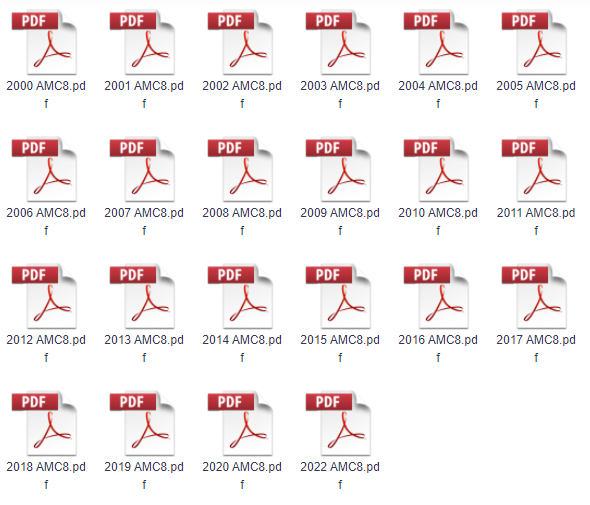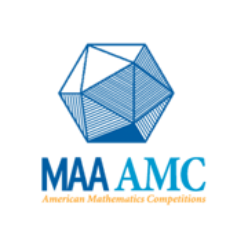2009年AMC 8 真题:
Problem 1
Bridget bought a bag of apples at the grocery store. She gave half of the apples to Ann. Then she gave Cassie 3 apples, keeping 4 apples for herself. How many apples did Bridget buy?
![]()
Problem 2
On average, for every 4 sports cars sold at the local dealership, 7 sedans are sold. The dealership predicts that it will sell 28 sports cars next month. How many sedans does it expect to sell?
![]()
Problem 3
The graph shows the constant rate at which Suzanna rides her bike. If she rides a total of a half an hour at the same speed, how many miles would she have ridden?
![[asy] import graph; /* this is a label */ Label f; f.p=fontsize(0); xaxis(-0.9,20,Ticks(f, 5.0, 5.0)); yaxis(-0.9,20, Ticks(f, 22.0,5.0)); // real f(real x) { return x; } draw(graph(f,-1,22),black+linewidth(1)); label("1", (-1,5), black); label("2", (-1, 10), black); label("3", (-1, 15), black); label("4", (-1, 20), black); dot((5,5), black+linewidth(5)); dot((10,10),black+linewidth(5)); dot((15,15), black+linewidth(5)); dot((20,20), black+linewidth(5)); label("MINUTES", (11,-5), S); label(rotate(90)*"MILES", (-5,11), W);[/asy]](https://latex.artofproblemsolving.com/5/2/9/529abcc0ef72bb26b76d853577665d862396aab5.png)
![]()
Problem 4
The five pieces shown below can be arranged to form four of the five figures shown in the choices. Which figure cannot be formed?![[asy] defaultpen(linewidth(0.6)); size(80); real r=0.5, s=1.5; path p=origin--(1,0)--(1,1)--(0,1)--cycle; draw(p); draw(shift(s,r)*p); draw(shift(s,-r)*p); draw(shift(2s,2r)*p); draw(shift(2s,0)*p); draw(shift(2s,-2r)*p); draw(shift(3s,3r)*p); draw(shift(3s,-3r)*p); draw(shift(3s,r)*p); draw(shift(3s,-r)*p); draw(shift(4s,-4r)*p); draw(shift(4s,-2r)*p); draw(shift(4s,0)*p); draw(shift(4s,2r)*p); draw(shift(4s,4r)*p); [/asy]](https://latex.artofproblemsolving.com/c/4/f/c4f79ad76fa1db088553b2ed970eec53d2fdb878.png)
![[asy] size(350); defaultpen(linewidth(0.6)); path p=origin--(1,0)--(1,1)--(0,1)--cycle; pair[] a={(0,0), (0,1), (0,2), (0,3), (0,4), (1,0), (1,1), (1,2), (2,0), (2,1), (3,0), (3,1), (3,2), (3,3), (3,4)}; pair[] b={(5,3), (5,4), (6,2), (6,3), (6,4), (7,1), (7,2), (7,3), (7,4), (8,0), (8,1), (8,2), (9,0), (9,1), (9,2)}; pair[] c={(11,0), (11,1), (11,2), (11,3), (11,4), (12,1), (12,2), (12,3), (12,4), (13,2), (13,3), (13,4), (14,3), (14,4), (15,4)}; pair[] d={(17,0), (17,1), (17,2), (17,3), (17,4), (18,0), (18,1), (18,2), (18,3), (18,4), (19,0), (19,1), (19,2), (19,3), (19,4)}; pair[] e={(21,4), (22,1), (22,2), (22,3), (22,4), (23,0), (23,1), (23,2), (23,3), (23,4), (24,1), (24,2), (24,3), (24,4), (25,4)}; int i; for(int i=0; i<15; i=i+1) { draw(shift(a[i])*p); draw(shift(b[i])*p); draw(shift(c[i])*p); draw(shift(d[i])*p); draw(shift(e[i])*p); } [/asy]](https://latex.artofproblemsolving.com/f/b/4/fb48f64accc93ee27ac75f695ac7d512c9e12f7a.png)
![]()
Problem 5
A sequence of numbers starts with ![]() ,
, ![]() , and
, and ![]() . The fourth number of the sequence is the sum of the previous three numbers in the sequence:
. The fourth number of the sequence is the sum of the previous three numbers in the sequence: ![]() . In the same way, every number after the fourth is the sum of the previous three numbers. What is the eighth number in the sequence?
. In the same way, every number after the fourth is the sum of the previous three numbers. What is the eighth number in the sequence?
![]()
Problem 6
Steve's empty swimming pool will hold ![]() gallons of water when full. It will be filled by
gallons of water when full. It will be filled by ![]() hoses, each of which supplies
hoses, each of which supplies ![]() gallons of water per minute. How many hours will it take to fill Steve's pool?
gallons of water per minute. How many hours will it take to fill Steve's pool?
![]()
以下是我们为您整理的中英双语真题试卷,还有全英版真题供您选择
扫码即可免费领取完整版:



更多AMC 8 历年真题+真题详解
扫码添加顾问即可免费领取

